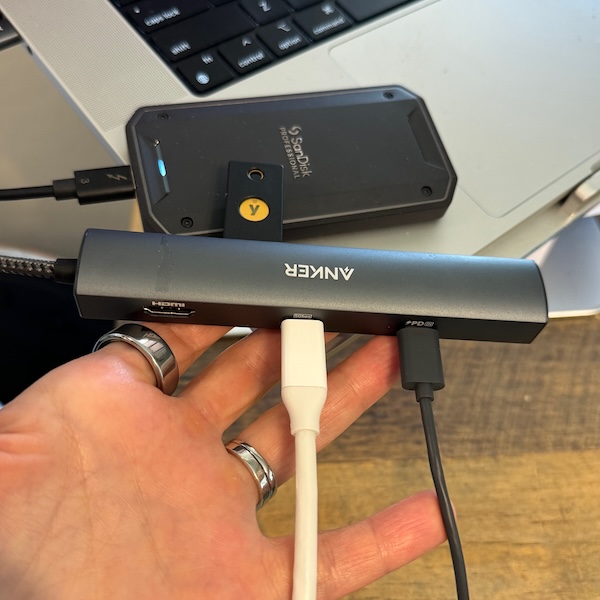What if I Only Have One USB-C Port?
No ratings yet.May 27, 2025 at 7:20 AM
Categories: Decipher VoiceMail, Decipher Backup Browser, Decipher TextMessage, Decipher Chat | View Comments
We recently had a customer write in and ask:
I have a Mac 💻, it only has a c to c charging cord. No USB port. How do I connect my iPhone?
With the evolution of technology, many devices, including the latest MacBook models, feature limited ports, which can sometimes be a puzzle when it comes to connecting USB peripheral devices. It can also be stressful to balance the need to connect iPhones, external drives, and other USB accessories with the need to keep your Mac plugged in to power and charging. Fear not! In this comprehensive guide, we'll walk you through the ideas and solutions to seamlessly connect your iPhone to your Mac, ensuring smooth data transfer, charging, and more, all through that single USB-C port. Let's dive in!
Your Mac's Charging Plug is a USB-C Port
If you're not worried about running out of power on your Mac while you connect your iPhone, you can unplug your Mac's charging cable temporarily and connect your iPhone directly to the one USB-C port.
-
For an iPhone 15/iPhone 15 Pro/iPhone 16/iPhone 16 Pro, you would use a USB-C to USB-C cable for that.
-
For an iPhone model before the iPhone 15, you would want to use a USB-C to Lightning cable.
But What if I Need to Charge my Mac at the Same Time?
If you want to keep your Mac plugged in to power while also connecting other USB-A or USB-C devices, you will need a hub power delivery. The USB Power Delivery feature was made to save those of us with only one USB port on our Macs. From USB.org:
The USB Power Delivery (USB PD) Specification enables the maximum functionality of USB by providing more flexible power delivery along with data over a single cable. Its aim is to operate with and build on the existing USB ecosystem.
USB hubs with a USB Power Delivery (USB PD) port not only allow for the data connections with USB peripheral devices that you want, but also allow you to plug your charger into the Power Delivery (PD) port to power your Mac! Using a USB hub that supports Power Delivery, you can still connect your charger to your MacBook through the hub, and then also connect other USB devices to the hub as well.
I recently bought and tested this Anker USB hub so I could vet a USB hub with Power Delivery for this FAQ post. I'm a bit of an extreme test case because I need to connect multiple test iPhones and iPads to make backups, I use a USB-A external drive and a USB-C external drive, and I connect my USB-A Yubikey to my MacBook pro.
I chose the Anker hub because it:
- Plugs in to the USB-C port on my MacBook Pro.
- Has a “Power Delivery” port to plug a powered USB-C cable into.
- Has more ports for all my USB gizmos - both USB-C and USB-A.
My Anker 6-in-1 USB C Hub in use on my MacBook Pro.
To use the USB Power Delivery hub:
- Plug the USB hub in the single USB-C port on your Mac.
- Then you can plug the Mac's charger into the specifically marked "PD In" USB-C port on the hub to provide power to your Mac.
- You can now plug in your existing iPhone cable or other USB devices into one of the other USB ports. It has both kinds of USB ports, the newer USB-C ports and the USB-A ports you're more used to seeing.
The photos in this post are of my Anker USB-C hub with:
- A USB-C cable connecting my iPhone 15 Pro.
- A USB-C charging cable connected to the Power Delivery port.
- My Yubikey connected to one of the USB-A ports.
My SanDisk USB-C hard drive is in the background, but it is connected directly to one of my other USB-C ports, because if I have a port directly on my Mac, I would rather plug the external drive in there.

Another view showing the two 5Gbps USB-A ports
I would be remiss to also not mention a few other points about Mac's with a single USB-C port:
-
As mentioned before, if you're not worried about running out of power while you connect your iPhone, you can unplug your Mac's charging cable temporarily and connect your iPhone directly to the one USB-C port.
For an iPhone 15 or 16/15 or 16 Pro, you would use a USB-C to USB-C cable for that.
For an iPhone model before the iPhone 15, you would want to use a USB-C to Lightning cable.
-
If you're fancy and you want the ultimate USB-C hub, the Apple Studio Display has three USB-C ports on the back and connects to the Mac via USB Power Delivery, so it can charge your Mac through that one USB-C port. 😉
You may have noticed that there are links to amazon.com in this blog post — as an Amazon Associate, we earn from qualifying purchases.
Our primary business is making our Decipher Tools software and solving iPhone problems, but occasionally while writing a tutorial, we find a solution that involves recommending buying an item, like a cable or case. We take external product recommendations very seriously, and we only link to products that we have actually tested ourselves.









